hockey stick size guide
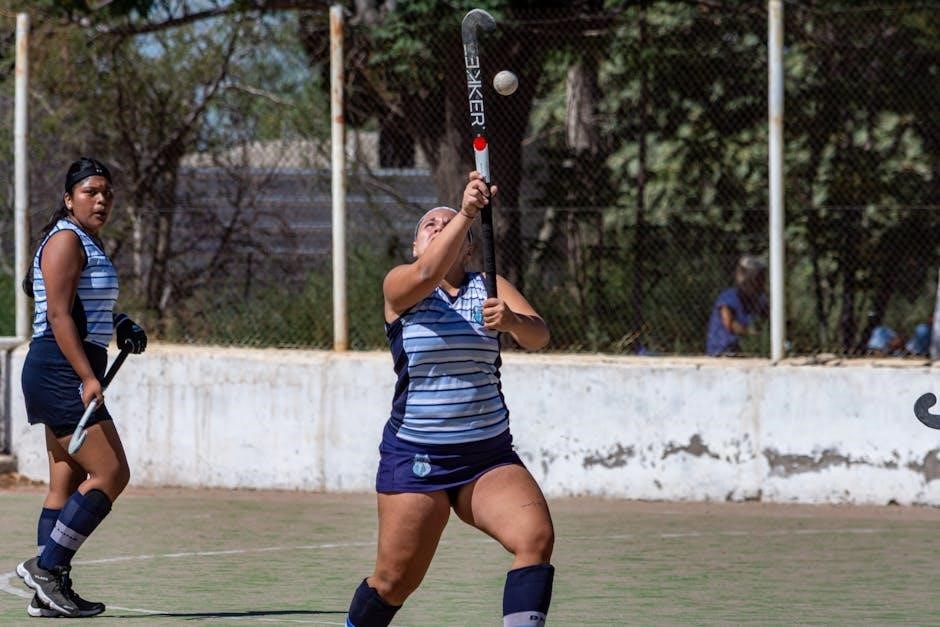
Proper hockey stick sizing is crucial for performance and comfort. Factors like height, weight, and playing style influence the ideal fit. A well-sized stick enhances control, accuracy, and power. Personal preference also plays a role, making it essential to try sticks before buying.
1.1 Importance of Proper Fit
A proper fitting hockey stick is essential for optimal performance, comfort, and safety on the ice. A stick that is too long or too short can hinder a player’s ability to control the puck, shoot accurately, and maintain balance. Incorrect sizing can lead to poor technique, reduced power in shots, and increased fatigue during games. Additionally, an ill-fitting stick may result in discomfort or even injury, particularly if it interferes with proper skating mechanics or stickhandling.
For goalies, precise measurements are critical to ensure the stick’s paddle and shaft align with their body position, allowing for better control when blocking shots. For forwards and defensemen, proper fit enables efficient stickhandling, passing, and shooting. A stick that matches a player’s height, weight, and playing style also enhances their ability to maneuver and react quickly during fast-paced gameplay.
Moreover, the right fit helps players develop proper skating and shooting techniques from the start, especially for younger or less experienced players. Investing time in finding the correct size ensures a more enjoyable and effective hockey experience. Proper fit is the foundation of skill development and peak performance.
1.2 Overview of Sizing Factors
When determining the right hockey stick size, several key factors come into play. These include stick length, flex rating, kick point, and blade pattern. Stick length is measured from the heel of the blade to the top of the shaft and typically ranges from 48 to 60 inches. Proper length ensures the stick reaches the player’s chin or nose when standing upright without skates, adjusting slightly when on skates.
Flex rating refers to the stick’s stiffness, measured in pounds, and varies from youth (40-50 flex) to senior (70-110 flex). The right flex allows players to generate power without straining. Kick point is the point along the shaft where it flexes most during shooting, with options like low, mid, or high kick points catering to different shooting styles.
Blade pattern involves the curve and shape of the blade, affecting puck control and shooting accuracy. Players choose patterns based on their position and style of play. Understanding these factors helps in selecting a stick that aligns with individual needs, ensuring better performance and comfort on the ice.
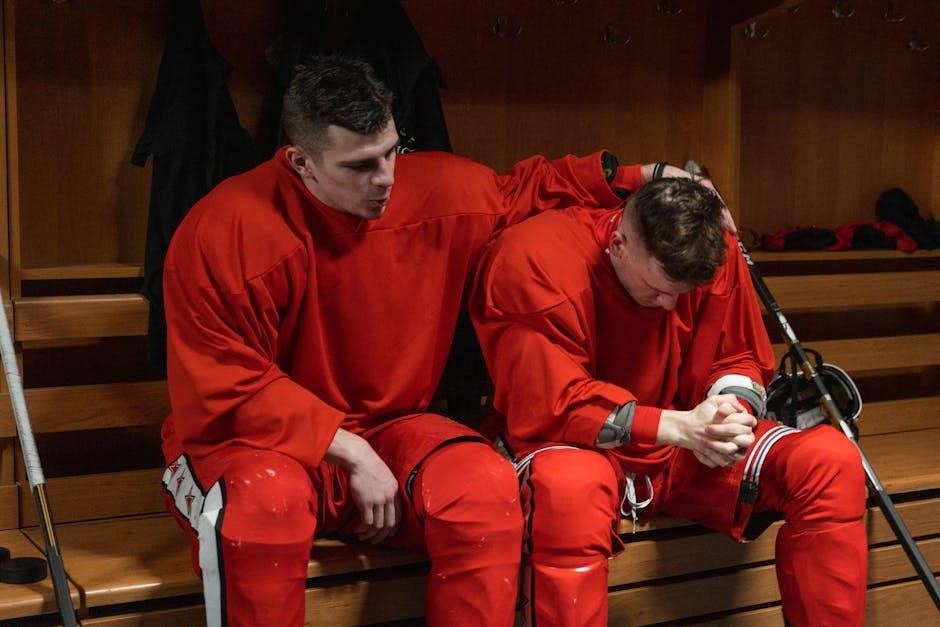
Key Factors in Choosing a Hockey Stick
Stick length, flex rating, kick point, and blade pattern are essential considerations. These factors influence performance, comfort, and control, ensuring the stick aligns with the player’s height, weight, and playing style for optimal results on the ice.
2.1 Stick Length
Stick length is a critical factor in determining comfort and performance. Generally, a hockey stick should reach the player’s nose when standing upright without skates. On-skates, it typically reaches the chin or slightly below, allowing for proper control and reach. For younger players or those still growing, sticks may be left longer to accommodate future height increases. However, personal preference plays a significant role, as some players prefer shorter sticks for easier handling, while others opt for longer ones to enhance reach. Proper stick length ensures optimal puck control and shooting accuracy, making it essential to measure accurately. Players should consider their skating stance and style when choosing the ideal length, as these can influence how the stick feels during gameplay. Ultimately, the right stick length balances comfort, performance, and personal preference, ensuring the player can maneuver effectively on the ice.
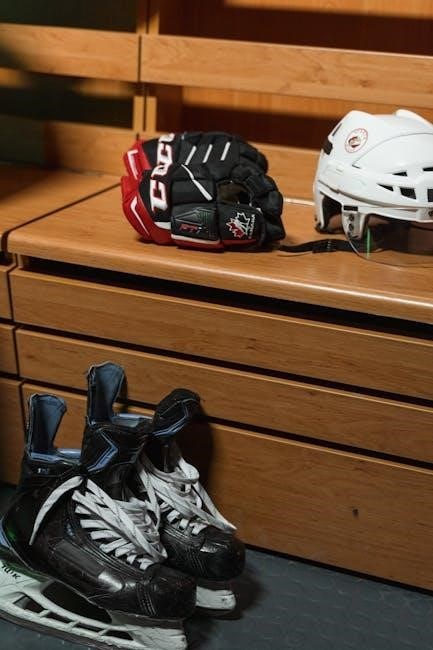
2.2 Flex Rating
Flex rating refers to a hockey stick’s stiffness, measured by how much it bends under pressure. A lower flex rating indicates a more flexible stick, while a higher rating means greater stiffness. The right flex depends on the player’s strength, skill level, and playing style. Younger or less experienced players often prefer a lower flex, as it is easier to bend and control, allowing for better feel and accuracy. Conversely, stronger, more advanced players opt for higher flex ratings to generate powerful shots and maintain stability during hard passes or slapshots.
Activating the flex requires proper technique, and using a stick that is too stiff can hinder performance. It’s important to match the flex rating to the player’s ability to bend the stick effectively. Personal preference also plays a role, as some players prioritize responsiveness over power or vice versa. Ultimately, the flex rating should complement the player’s strength and style to maximize performance on the ice.
2.3 Kick Point
The kick point of a hockey stick refers to the point where the stick flexes most during shooting, significantly impacting performance. It is typically located near the bottom of the shaft and varies by design; A mid-kick point, found in sticks like the Bauer Nexus, offers a balance between power and control, making it suitable for players who take a variety of shots. Hybrid kick points combine elements of mid and low kick points, providing quick release and stability, ideal for players who prioritize accuracy and speed. Low kick points are designed for quick, snappy releases, favored by forwards and players who rely on fast, precise shots.
The kick point affects how the stick loads and releases energy during a shot. Players with a strong shooting technique may prefer a mid or hybrid kick point for maximum power, while those focused on quick releases benefit from a low kick point. Personal preference and playing style are key factors in choosing the right kick point. Trying different sticks helps determine which kick point aligns best with individual needs, ensuring optimal performance on the ice.
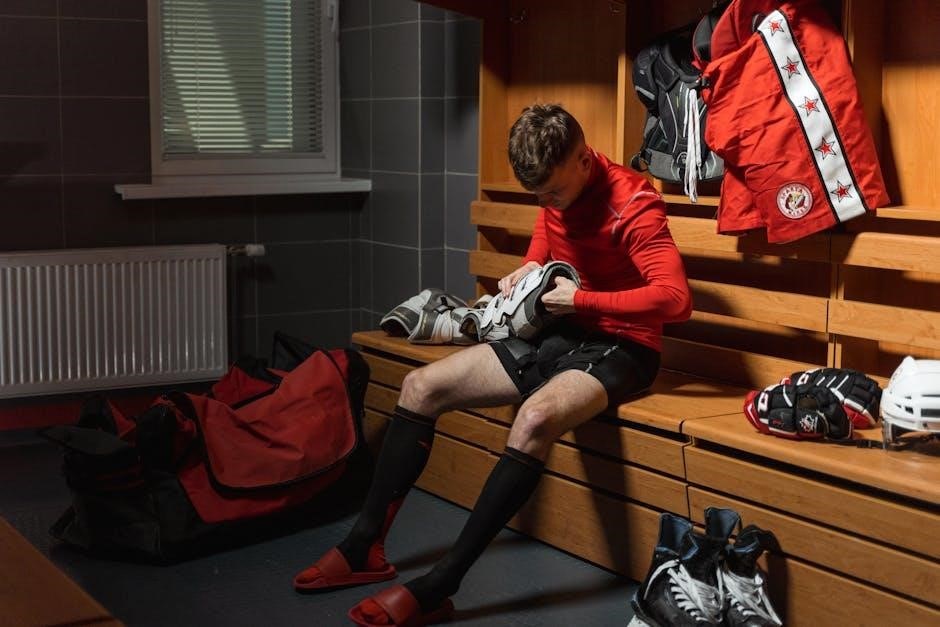
2.4 Blade Pattern
The blade pattern of a hockey stick plays a crucial role in puck control, shooting accuracy, and overall performance. It refers to the curve of the blade and its impact on how the puck behaves during stickhandling and shooting. Blade patterns vary in depth, length, and shape, catering to different playing styles and preferences.
A mid-curve blade pattern is the most common, offering a balance between puck control and shooting ability. It is ideal for players who prioritize versatility in their game. A deeper heel curve is preferred by players who rely on powerful slapshots, as it provides a larger sweet spot for impact. Conversely, a toe curve is favored by those who excel in quick, precise wrist shots and stickhandling.
Blade patterns also influence how the puck lifts off the stick. A more open face allows for easier lifting, while a flatter face is better for keeping shots low and accurate. Personal preference and positional demands often dictate the choice of blade pattern. For example, forwards may opt for a more pronounced toe curve for quick releases, while defensemen might prefer a mid-curve for balanced performance.
Ultimately, the blade pattern should complement a player’s style and strengths, making it essential to test different options before committing to a stick.
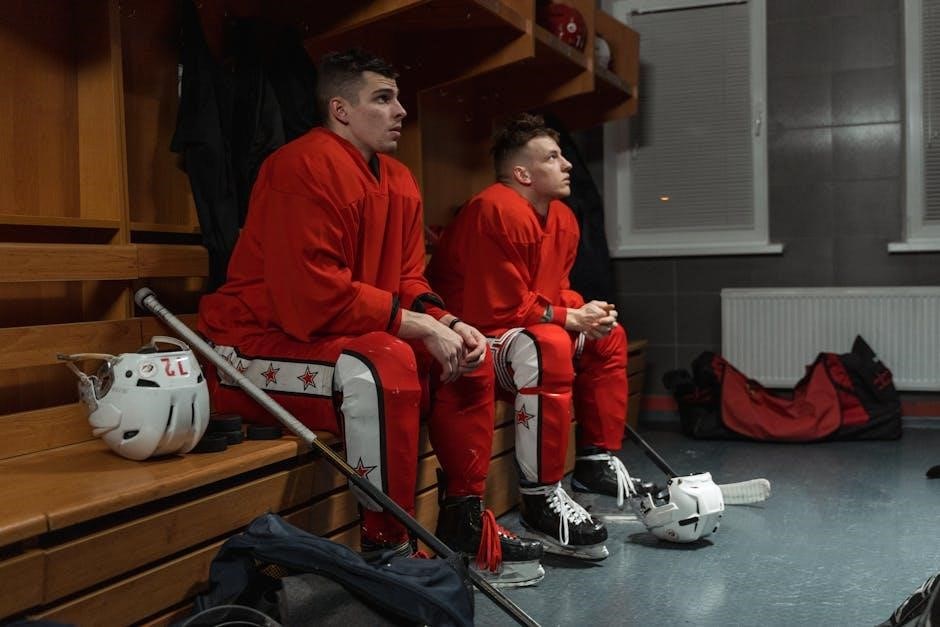
Measuring Techniques for the Perfect Fit
Measure by standing upright with the stick blade on the ground, reaching just below the chin. On skates, it should be 1-2 inches below the chin. Mark and cut for a custom fit, ensuring comfort and optimal performance.
3.1 Standing Upright Measurement
Standing upright measurement is a common method to determine the ideal hockey stick length. Place the stick vertically with the blade on the ground and the handle against a wall. Mark the point where the stick reaches just below your chin. This measurement ensures the stick is proportional to your height, providing a comfortable grip and control. For most players, the stick should reach the tip of the nose when standing without skates. If you prefer a shorter stick for better handling, you can cut it down slightly. This method is straightforward and effective for determining the baseline length before fine-tuning based on personal preference or skating position.
When measuring on skates, the stick should typically reach 1-2 inches below the chin due to the added height from the skates. This adjustment ensures the stick remains functional and comfortable during gameplay. Marking the stick accurately is crucial, as it directly impacts performance and feel on the ice.
Ultimately, the standing upright measurement serves as a reliable starting point. However, personal preference, such as how you hold the stick or your skating stance, may require further adjustments. Always consider these factors to achieve the perfect fit for your game.
3.2 On-Skates Measurement
Measuring your hockey stick while on skates provides a more accurate fit for gameplay. Stand with your skates on, place the stick vertically with the blade on the ground, and measure from the ground to the top of the handle. The stick should typically reach just below your chin when wearing skates, as this accounts for the added height they provide. This method ensures the stick length is appropriate for your skating stance and comfort level.
Some players prefer their sticks slightly shorter for better puck control, while others opt for a bit more length for reach. Personal preference plays a significant role here, as skating posture and style can influence the ideal measurement. For example, a more upright skater might prefer a shorter stick, while a player with a lower stance might prefer a longer one. Always consider how the stick feels during movement and shooting when finalizing your choice.
On-skates measurement is a practical approach to determining the perfect stick length, balancing comfort, control, and performance. It’s a key step in ensuring your equipment complements your game.
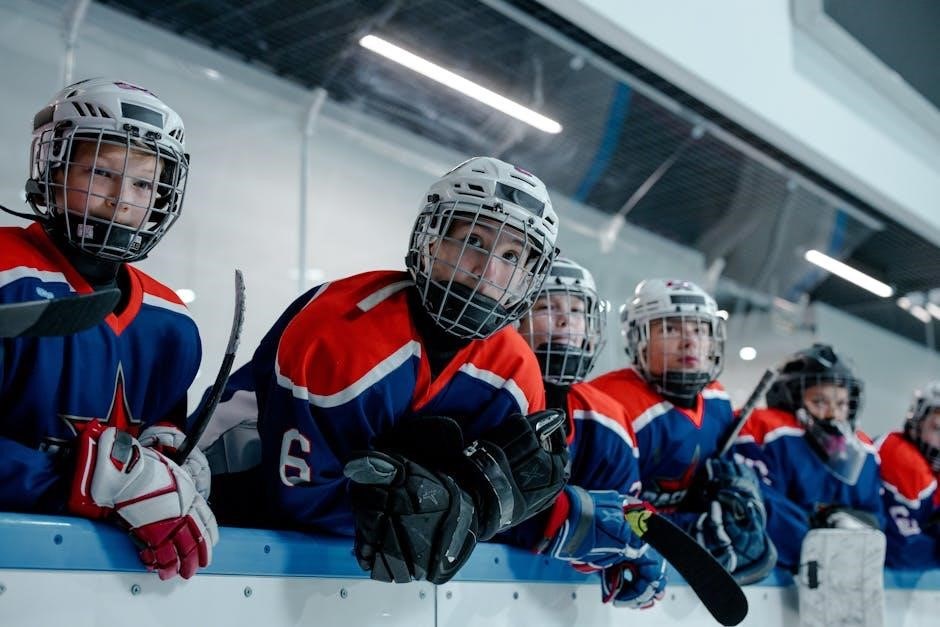
The Role of Personal Preference
Personal preference significantly impacts hockey stick sizing. Players may prioritize stick length, flex, or blade pattern based on comfort and performance. Individual skating posture, arm length, and playing style also influence these choices, making customization essential for optimal fit and effectiveness.
4.1 Height and Weight Considerations
Height and weight are fundamental factors in determining the ideal hockey stick size. Taller players typically require longer sticks to maintain proper reach and control, while shorter players may prefer shorter sticks for better maneuverability. Weight also plays a role, as lighter players might benefit from a more flexible stick to generate power efficiently. However, these are general guidelines, and individual preferences can vary. For instance, a taller player with a more upright skating posture might opt for a slightly shorter stick to enhance agility, whereas a shorter player with a low center of gravity might prefer a longer stick for better reach. Ultimately, the stick should feel comfortable and allow for optimal performance. Consulting a sizing chart or seeking advice from a professional can help players find the right balance between height, weight, and stick dimensions. This ensures the stick complements their physical attributes and enhances their overall game.
4.2 Playing Style and Reach
A player’s style and reach significantly influence hockey stick sizing. Forwards, defensemen, and goalies have different needs due to their roles. Forwards often prefer shorter sticks for agility and quick stickhandling, while defensemen may opt for longer sticks to enhance reach and control. Goalies require unique sticks designed for blocking and maneuverability. Playing style also affects the stick’s length and flex. Players with an upright posture might prefer shorter sticks, while those with a lower center of gravity could benefit from longer sticks. Reach is another critical factor, as it impacts how comfortably a player can handle the puck and execute passes or shots. Proper reach ensures the stick isn’t too long, which can hinder control, or too short, which can limit effectiveness. Personal preference plays a significant role, as some players adjust their stick length based on how they skate or handle the puck. Ultimately, the stick should feel natural, allowing the player to perform at their best without discomfort or restriction.
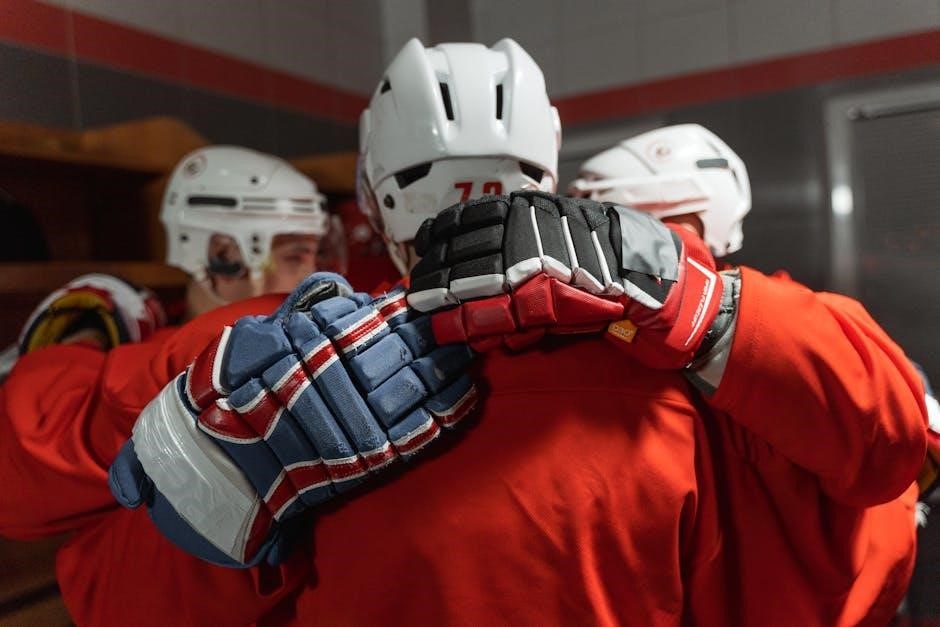
Understanding Brand Differences
Brands vary in stick measurements, flex ratings, and blade patterns. Bauer, CCM, and True Hockey offer distinct features. Trying sticks before buying is crucial to find the best fit for your style and preferences, ensuring optimal performance and comfort on the ice.
5.1 Variations in Stick Measurements
Stick measurements vary significantly across brands, with differences in length, flex, and blade patterns. Bauer sticks often feature a mid or hybrid kick point, while CCM tends to offer a more customizable fit. True Hockey is known for its precise engineering, catering to specific player needs. Each brand’s unique measurements can affect how the stick performs during gameplay, making it essential to understand these variations. For instance, some brands may have longer paddles or shorter shafts, which can impact a player’s reach and control. Additionally, the heel length of goalie sticks differs between brands, complicating standard measurements. These variations highlight the importance of trying sticks in person to ensure the best fit. By comparing different brands and their measurements, players can make informed decisions that align with their playing style and preferences, ultimately enhancing their performance on the ice.
5.2 Importance of Trying Before Buying
Trying a hockey stick before purchasing is crucial for ensuring the best fit and performance. Every player’s preferences and needs are unique, and what works for one person may not work for another. Brands often have slight variations in measurements, and these differences can significantly impact how the stick feels and performs. For example, some sticks may have a longer paddle or a shorter shaft, which can affect reach and control. Goalie sticks, in particular, have varying heel lengths, making it essential to test them in person. Many players find that their initial assumptions about the perfect stick change after trying it out. Additionally, the flex rating and kick point can feel different in practice than they do on paper. Experts recommend visiting a store to test multiple options, as this hands-on experience provides valuable insights. When trying a stick, consider how it feels during basic movements like shooting and passing. This step ensures that the stick aligns with your playing style and enhances your overall performance on the ice.
Stick Maintenance and Care
Proper maintenance ensures longevity and performance. Keep sticks dry, store upright, and avoid extreme temperatures. Regularly inspect for damage and sharpen blades as needed. These practices prevent deterioration and maintain optimal playability throughout the season.
6.1 Tips for Maintaining Your Stick

Proper maintenance is key to extending the life of your hockey stick. Keep it dry and store it upright to prevent warping. Avoid exposing it to extreme temperatures, as this can weaken the materials. Regularly inspect for cracks or damage, especially after games or intense practices. Sharpen the blade periodically to maintain puck control and shooting accuracy. Clean the stick with a damp cloth to remove dirt and grime, which can affect performance. Avoid using harsh chemicals, as they may damage the finish or composite materials. If you notice any significant wear or damage, consider replacing the stick to ensure optimal performance and safety. By following these simple care tips, you can preserve your stick’s integrity and enjoy consistent playability throughout the season.
Additionally, avoid using your stick as a prop or leaning on it excessively, as this can cause unnecessary stress. Store your stick in a protective bag when not in use to shield it from accidental damage. These habits will help maintain your stick’s condition and performance.
6.2 When to Replace Your Stick
Knowing when to replace your hockey stick is essential for maintaining performance and safety. If the stick shows visible damage, such as cracks, dents, or a loose blade, it’s time to consider a replacement. A cracked shaft can break during play, leading to missed opportunities or injuries. Additionally, if the stick’s flex rating feels inconsistent or the blade loses its shape, it may no longer perform as intended. Goalies should pay attention to the paddle and heel of their sticks, as wear in these areas can affect blocking and handling. For players, a significant change in height or weight may require a new stick to maintain proper fit. Even without visible damage, sticks can lose their pop and responsiveness over time due to repeated impact. If you notice a decline in performance or feel that the stick is no longer helping your game, it’s likely time for a replacement. Regularly inspecting your stick and replacing it when necessary ensures you can continue playing at your best.
Selecting the right hockey stick is a personal and critical decision that impacts performance, comfort, and enjoyment of the game. Proper sizing ensures optimal control, accuracy, and power, while a poor fit can hinder skills and lead to frustration. Factors like height, weight, and playing style guide the choice, but personal preference and experimentation play a significant role. Trying sticks before buying is highly recommended, as brands and models vary in measurements and feel; Maintenance and care are equally important to extend the stick’s lifespan and performance. Replace your stick when it shows signs of wear or no longer meets your needs. Remember, the right stick is an extension of your game, so take the time to find one that feels like a natural fit. With patience and the right guidance, you can master the art of choosing and maintaining your hockey stick to elevate your skills and enjoy the game to the fullest.



